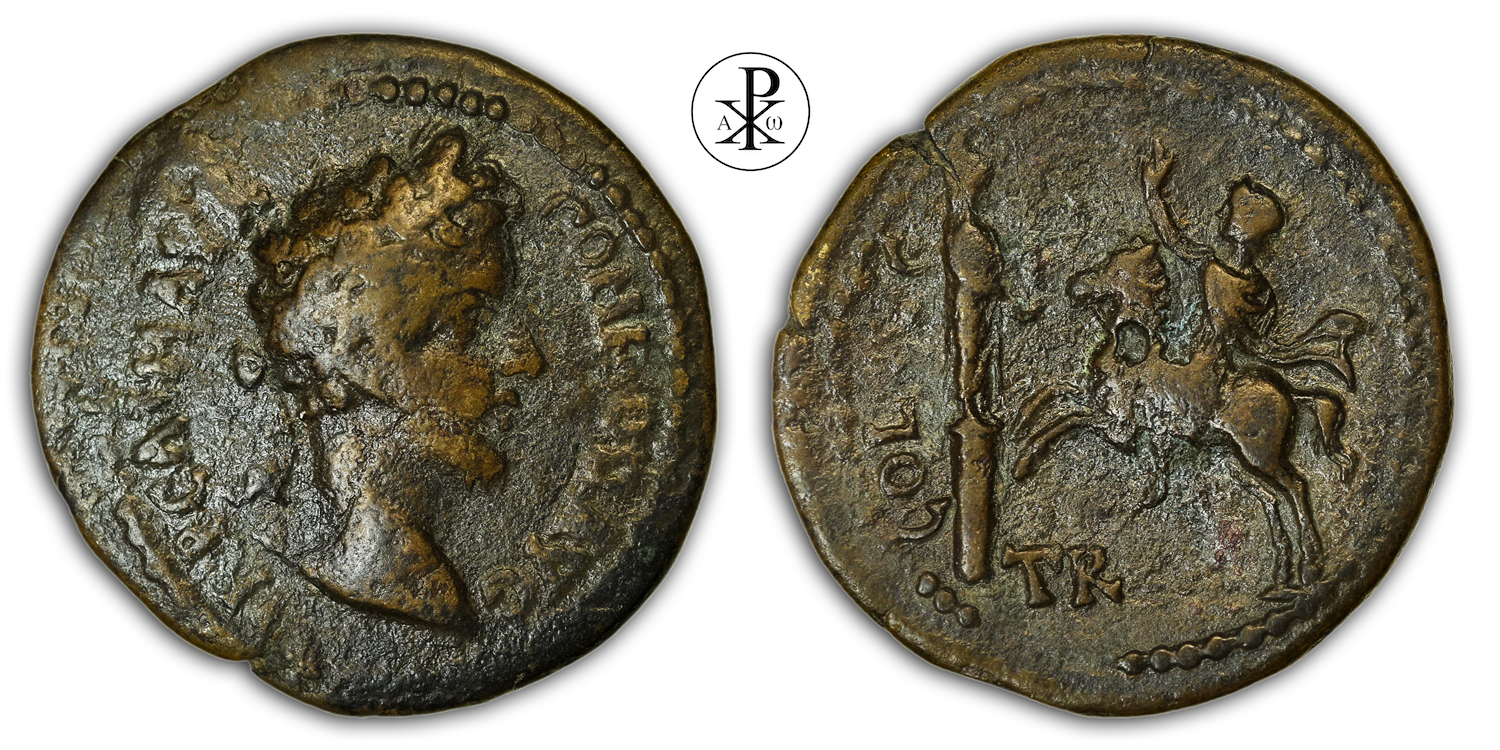Imperator Caesar Marcus Aurelius Commodus Antoninus Augustus
Reign: Commodus
Mint: Alexandria, Troas
Date: 180/191 AD
Nominal: Bronze
Material: AE
Diameter: 24.5mm
Weight: 6.79g
Reference: RPC IV.2 154 (#6 this coin)
RPC Online: https://rpc.ashmus.ox.ac.uk/coins/4/154
Rare: Specimens 6 (4 in the core collections)
Provenance: Comptoir des Monnaies Anciennes Lille, France
Pedigree: –
Obverse: Laureate head of Commodus, right
Inscription: IMP CAI(sic) M AVR COMMOD AVG
Translation: Imperator Caesar Marcus Aurelius Commodus Augustus
Reverse: To left, cult statue of Apollo Smintheus standing on column, right, having quiver at shoulder, holding patera and bow; to right, Alexander on horseback, left, wearing military dress, raising arm containing flowers
Inscription: COL AVG TROA
Translation: Colonia Augusta Troad (Troas)
Comment: Alexandria Troas is an ancient city in the Asia Minor landscape of Troas, which today belongs to the Turkish province of Çanakkale. It is located about 30 km south of Troy in the district of Ezine on the Aegean coast. On the reverse, shown on the right, we see Alexander the Great, in military dress, on a horse. The depiction thus refers to the alleged (and unhistorical) founding of the city of Alexandria Troas by Alexander the Great himself. However, the city was founded shortly after 310 BC by Antigonos I Monophthalmos (general and one of Alexander the Great’s most important diadochi) and named Antigonia, but was renamed Alexandria Troas by Lysimachus as early as 301/300 BC. The new city name resulted on the one hand from the honouring of Alexander the Great, but also to distinguish it by name from the cities of Alexandria ad Issum and Alexandria in Egypt. It is not clear whether this Hellenistic foundation was a new foundation or the renaming of an older settlement. However, the city only experienced its heyday in Roman times, as documented by written sources and buildings. Constantine the Great considered making it the capital of the Roman Empire, but chose Byzantium. Alexandria Troas also played a role in the spread of early Christianity. On three journeys, Paul visited Alexandria Troas. In his second letter to the Corinthians he refers to Troas by name (2 Cor 2:12-13 EU). Likewise, Ignatius of Antioch stayed in Alexandria Troas on his extradition journey to Rome, where he wrote three of the Epistles of Ignatius named after him. In 2003, a team of archaeologists from the Asia Minor Research Centre of the University of Münster, led by Elmar Schwertheim, found a stone slab in the city with a 90-line inscription from the time of Hadrian. It contains three letters from the emperor to the supra-regional association of competitors with regulations for various agons, specifying among other things the distribution of prize money to the winners as well as sanctions against those responsible for violations.
Also visible on the left is the cult status of Apollo Smintheus. Homer refers to Apollo in the Iliad as Smintheus. The etymology of the non-Greek word is not certain. It is derived from the Cretan or Phrygian word sminthos for „mouse“ or „rat“ and can be translated as „mouse exterminator“. To what extent Apollo Smintheus can be equated with Apollo as a plague god is unclear. Mice or rats may indicate plagues, which according to Greek mythology emanated from Apollo. But the epiklese was also chosen for the expulsion of mice that had ravaged the vineyards. The temple of Apollo Smintheus is the only one of its kind in the Troas region due to its architectural design in the Hellenistic period. The sanctuary of Smintheus was one of the most important cult centres in antiquity. The reliefs on the temple take up themes from Homer’s Iliad epic. It was probably built in the Hellenistic period around 150 BC. The temple housed a large marble statue of the god, of which only a leg section has survived. At the feet of the statue, according to tradition, sat a mouse, which may symbolize the role of this god. More information and pictures you can find here: https://www.antike-orte.de/apollon-smyntheion
